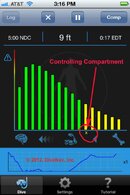Did a quick check through DAN and they go into some detail about this subject I have attached a link below and also I have included a couple of interesting paragraphs from the article.
International DAN research studies have recently clearly confirmed these hypotheses: 15 divers were enrolled in a study and each given eight possible combinations of ascent rates, and either a shallow stop, or a deep and a shallow stop. The repetitive dives were to 80 feet (25 meters) for 25 minutes; the surface interval was three hours, 30 minutes; and the final dive was to 80 feet for 20 minutes. Ascent rates were 60, 30 and 10 feet per minute. The matrix is shown in Table 3 and the results of 181 dives are shown in Table 4.
Clearly, the best decompression schedule is Profile 6 (see highlights in both tables). With an ascent rate of 33 feet (10 meters) per minute, and two stops at 45 feet (13.5 meters) and 9 feet (2.7 meters) respectively, this profile had the lowest bubble score of 1.76.
NAUI technical divers have used the Wienke RGBM model quite extensively with no recorded incidence of DCS. This data as well as the results of this IDAN research in divers were discussed at a NAUI workshop in Florida in early 2003. As a result, NAUI has now suggested that a deep stop might well be incorporated in recreational diving by taking a one-minute stop at half the depth and followed by a two-minute safety stop at the 15- to 20-foor level instead of the three minutes currently recommended. We are currently testing this concept with our Italian diver research teams.
DAN | News.
Hope you find this useful.




